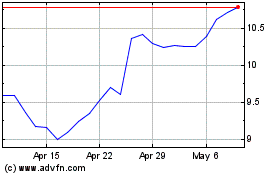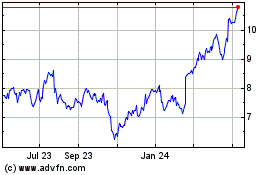Blockchain Firm R3 Files for a Patent as Fintech Race Heats Up--Update
August 24 2016 - 10:03AM
Dow Jones News
By Paul Vigna
R3 CEV, a startup working to build new Wall Street
infrastructure using bitcoin technology, said it had filed for a
patent this week and named its product Concord for the harmony it
aims to build among more than 60 banks.
The patent application is the New York firm's first, shedding
some light on what has so far been a widely followed but opaque
firm.
R3, launched in September 2015 with a consortium of nine
multinational banks, has since grown to more than 60 and includes
Barclays PLC, Goldman Sachs Group Inc., and J.P. Morgan Chase &
Co.
The goal of the firm has been create standards for financial
services based on "blockchain," the open-ledger system used to
trade the virtual currency bitcoin. It hopes to sell its wares both
to the participant banks and others.
With the filing, the firm is essentially unveiling its plans.
What it has built is something that looks in some respects like the
cryptocurrency bitcoin, but with significant differences to appeal
to banks.
Concord aims to be a universal software platform connecting bank
operations both within firms and across markets, aimed at
digitizing so-called middle- and back-office functions, like trade
clearing and settling, asset registry, and reconciliation, even the
recording of cash balances.
If it comes together, the platform could help banks streamline
cumbersome operations, lower the costs of maintaining them, and
realize billions of dollars in savings.
"I don't think there's ever been a time when there's been so
much pressure on banks," said David Rutter, R3's founder and CEO,
amid post-crisis regulations, a tough capital environment, and
pressure to cost costs. "It's been difficult if not impossible for
these big banks to cut costs in a significant way."
A version of Concord is expected to be launched in the next
several months, R3 executives told The Wall Street Journal, with a
small number of banks using it to test some services early in 2017.
It hopes to launch an "alpha" version by mid-year. "We need to make
this real to business users in 2017," said Todd McDonald, R3
co-founder and chief operating officer.
Figuring out the best way to use blockchain-based tools in the
financial-services industry has become a hot topic. Virtually every
major multinational bank is involved in one or multiple working
groups. A number of firms, including Digital Asset Holdings,
Hyperledger Project, Ripple, Microsoft's Azure, and others are all
working on products to take advantage of the new technology.
In many ways, Concord resembles ethereum, the bitcoin offshoot
being built as a platform for application hosting. Concord, too, is
viewed as a platform that will allow developers to build any
variety of applications. But it is tailored expressly for financial
institutions, and so has different features and functions.
Perhaps the most important difference between Concord and
bitcoin and ethereum is the way transactions are recorded. With
bitcoin and ethereum, every transaction is recorded, verified and
disclosed immediately in their respective public, distributed
ledgers. With Concord, while the transaction is verified via a
distributed ledger, it is not publicly disclosed. The details are
shared only by the parties involved, or parties to whom they give
access.
Maintaining this confidentiality was a key concern of R3's
members banks, said Mr. McDonald. R3 also worked with and met with
more than 70 global regulators during development.
Concord is the result of a "total reimagining of the back
office," Mr. McDonald said. The firm describes Concord as a
"shared-services model" that still maintains privacy for banks.
The banks in R3's consortium have not committed to the new
platform, and indeed aren't bound to use it, Mr. McDonald said.
However, they've invested money and resources in helping build it,
and also had input into Concord's specifications.
While Concord does resemble other platforms, R3 felt it offered
enough unique features that it justifies a patent. One other
difference between Concord and bitcoin: Concord doesn't have a
coin.
Write to Paul Vigna at paul.vigna@wsj.com
(END) Dow Jones Newswires
August 24, 2016 09:48 ET (13:48 GMT)
Copyright (c) 2016 Dow Jones & Company, Inc.
Barclays (NYSE:BCS)
Historical Stock Chart
From Mar 2024 to Apr 2024

Barclays (NYSE:BCS)
Historical Stock Chart
From Apr 2023 to Apr 2024
